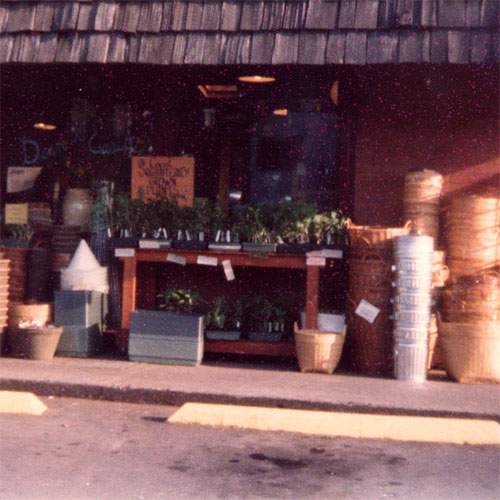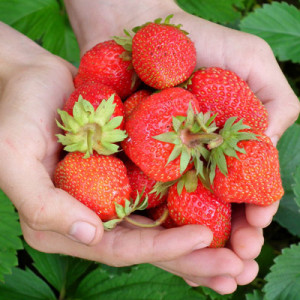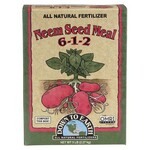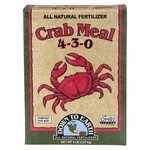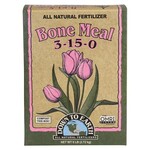Down To Earth™ began in Eugene, Oregon, in 1977 in response to the growing segment of American consumers who were looking for alternatives to plastic and synthetic materials. On the forefront of the burgeoning organic movement of the 1980s, we began making fertilizers out of our storefront shop to provide our customers a natural, economical option for their gardens.
Today, we work out of our own manufacturing plant and have developed partnerships with processors and suppliers to procure the highest quality raw materials for our premium fertilizer products, which are used by home gardeners, commercial growers, nurseries and garden centers who want environmentally friendly alternatives to conventional chemical products.
We feature a complete line of natural and organic fertilizers, soil amendments, composts and potting media that work with the microorganisms, fungi and organic matter in the soil to feed plants and stimulate growth. Our natural fertilizers are carefully blended from the best sources of organic nutrients in ideal proportions without the use of synthetics, growth stimulants or low-quality fillers like poultry waste. You can be confident that you are giving your farm or garden the best product available, whether it’s a multi-purpose blend or a specialized soil amendment.
We take pride in offering only the highest quality ingredients that help provide an effective and environmentally friendly approach to plant care, crop fertilization and soil management.
Organic Fertilizers are derived from plant, animal or mineral resources, and combined with organic matter.
Organic Fertilizers are ideal for enhancing soil fertility and stimulating plant growth in a sustainable and environmentally friendly way. Organic fertilizers add nutrients to the soil for uptake by plants and for use by the myriad microorganisms that inhabit healthy, productive soil. Fertilizers are available as single ingredient nutrients or as complete blends with multiple applications.
Why choose organic fertilizer over a synthetic?
The main advantage of using organic fertilizer is that you are building your soil for years to come instead of depleting it.
Natural and Organic Fertilizers help strengthen soil health. Our fertilizers are an ecosystem friendly alternative to chemical fertilizer and soil amendments. Chemical fertilizers are known to deplete soil microorganisms and leach into waterways, creating large ‘dead zones’ where water no longer contains oxygen for marine life.
The main advantage of using organic fertilizer is that you are building your soil for years to come instead of depleting it. By enhancing soil fertility and stimulating plant growth in a sustainable and environmentally friendly way, organic fertilizers will add nutrients to the soil for uptake by plants over time. These nutrients are also used by the myriad of microorganisms that inhabit healthy, productive soil, which in turn benefit plant growth, and increase plant immunity and tolerance to heat and drought conditions.
What is NPK?
NPK is abbreviation for the macronutrient combination of nitrogen, phosphorus and potassium.
Fertilizers are labeled with numbers that represent the percentage of the three primary macronutrients – nitrogen (N), phosphorus (P) and potassium (K) – that are immediately available in the fertilizer. These elements are listed as the NPK ratio. For example, our All Purpose Mix 4-6-2 is comprised of each primary nutrient, whereas our
Blood Meal 12-0-0 is a single ingredient source of nitrogen. Each nutrient plays specific and complementary roles. Very generally, nitrogen energizes vegetative growth, phosphorus produces expansive roots, flowers, fruits and viable seeds, while potassium (or potash) promotes sturdy stems, plus resistance to disease and temperature stress. Most fertilizers will also contain varying amounts of the secondary macronutrients – calcium, sulfur and magnesium – along with trace elements or micronutrients that also play essential roles in plant nutrition.
Are your products organic?
Yes and No. Simply put our products with an OMRI logo on them are certified to be used in organic crop production.
We make a conscious choice not to label our fertilizer products as “organic” for one simple reason, “USDA Organic” refers to certified food and fiber products, not the inputs or fertilizers used to produce them. We feel the term “organic,” when misused in association with fertilizer products, is misleading to consumers and has contributed to the trend of diminishing the true value of the organic label.
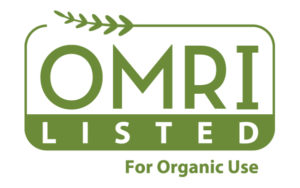 One of the certifications we proudly support is having our products independently verified by the Organic Materials Review Institute (OMRI). OMRI is an accredited non-profit organization that reviews fertilizer products to determine if they are compliant with the NOP standards for certified organic crop inputs. We began listing our products with OMRI in 2007 and now have over 45 products approved for use in organic crop production. OMRI verifies that products are free from genetically modified organisms as well as numerous other prohibited substances and additives.
One of the certifications we proudly support is having our products independently verified by the Organic Materials Review Institute (OMRI). OMRI is an accredited non-profit organization that reviews fertilizer products to determine if they are compliant with the NOP standards for certified organic crop inputs. We began listing our products with OMRI in 2007 and now have over 45 products approved for use in organic crop production. OMRI verifies that products are free from genetically modified organisms as well as numerous other prohibited substances and additives.
Are higher NPK amounts better?
No, higher NPK amounts don’t always mean higher quality or more effective fertilizer.
To someone accustomed to the higher NPK ratios of chemical fertilizers, such as 18-51-20, the modest amounts occurring in organic fertilizers may appear inadequate. However, nothing could be further from the truth; organics break down at a slower rate. Nitrogen supplying organic fertilizers contain insoluble nitrogen that releases slowly with greater effectiveness than conventional fertilizer, and reducing the need to reapply fertilizers as often in order to maintain soil fertility. Organics minimize the possibility of “burning” plants with concentrated chemical supplies of nutrients. They improve overall soil health rather than degrade it, by encouraging soil microbial life to flourish. Since organic fertilizers last longer and release their nutrients slowly, their long-term NPK amounts will be greater and more beneficial than what is shown on the label.
What form do fertilizers come in?
Organic fertilizers are sold in three forms: dry, water-soluble powder and liquid.
Dry fertilizers come in several textures: pulverized powder, meal, granulated and pelletized. They can be broadcast or spread over garden soils and lawns, and also incorporated into potting soils to provide nutrients to transplants and new plants. Dry organic fertilizers generally meet plants’ needs by releasing their nutrients
Soluble powder fertilizers begin to break down immediately, so they can be applied to the top few inches of soil for quick release, or transformed into a liquid fertilizer for foliar feeding or for use in irrigation systems. A foliar tea can be made by soaking the fertilizer powder overnight in a cloth bag suspended in a container of water. In the morning, empty the residue that is left in the bag around your garden, and pour or spray the richly colored liquid on garden plants.
Liquid fertilizers usually come as a concentrate and need to be diluted with water before using in your garden or to feed your houseplants. Both teas and dilutions can be applied with watering cans, hose end sprayers or through irrigation systems in a method known as fertigation. Tea and liquid soil feedings work best after a light rain or regular watering when the soil is more absorbent. Teas and liquids can also be applied directly to the leaves and bark of plants and trees using the above mentioned foliar feeding methods. Foliar sprays can be more effective than soil applications in correcting nutritional deficiencies and treating stress related problems under some conditions. For best results, spray early in the morning and when the air temperature is below 85° F.
Single Ingredients or Blends?
It depends on what your plants need.
Single Ingredient Fertilizers are used for specific plant needs and in certain stages of a plant’s development. For example, a high nitrogen source like Feather Meal 12-0-0 is used when heavy feeding plants, such as corn, need an additional boost early in the season. To promote big, beautiful blooms on your flowering plants, utilize a high phosphorus fertilizer, such as our Seabird Guano 0-11-0 or Bat Guano 0-7-0.
Fertilizer Blends, on the other hand, are used for more general needs around the home and garden. Our All Purpose Mix 4-6-2 is ideal for vegetables, flowers and trees as well as houseplants. A great advantage of multipurpose blends is that they save gardeners time and labor by offering a variety of single ingredients pre-mixed in exact and balanced proportions.
Will I be able to tell if I am feeding my plants the wrong amount?
Yes, and luckily, the signs that your plants have a nutrient imbalance are easily recognizable.
Too much nitrogen produces dark green foliage, few or no flowers or fruits and burnt leaf tips. Too little nitrogen produces light green to yellow leaves and slow growth, especially in the lower leaves of older plants.
An excess of phosphorous is rare, yet when it does occur symptoms are similar to an excess of nitrogen. A phosphorous deficiency is revealed by deep green, red or purple leaves, few blooms and fruits, yellowing bottom leaves and stunted growth.
Potassium toxicity will create nitrogen, phosphorous and trace mineral imbalances. Potassium deficiency produces very tall plants with weak stems as well as leaf tips and edges turning yellow, then brown later.
Too much calcium and magnesium increase potassium problems, and can also inhibit reciprocal uptake of each other. Too little calcium will cause young leaf tips to die back, blossom end rot on tomato fruits, short roots, stunted growth and rotten plant centers. Magnesium deficiencies show up in leaf tips turning brown and curling upwards in a hook shape.
When do your fertilizers expire?
Down To Earth’s dry fertilizer products without ‘biology’ will not expire if stored under the proper conditions.
Down To Earth products with ‘biology’ carry a two year expiration date.
With the exception of products containing biology (Bio-Live, Tree & Shrub, Starter Mix, Root Growth Enhancer and Root Zone) all of Down To Earth’s dry fertilizer products are indefinitely stable when stored dry and away from pests.
The products listed above, which contain beneficial bacteria and/or mycorrhizae, carry a two-year expiration date from the production date stamped on the packaging. These should be stored dry at room temperature for maximum viability.
Ahhhh! My pet ate fertilizer - what do I do?
It can be very worrisome for any of us when our pets eat something suspect. Fortunately, you can most likely rest easy.
Down To Earth dry fertilizers contain no ingredients that are poisonous to dogs or cats. In fact, most of the products we manufacture and the ingredients we use are also major ingredients in pet or livestock feed; that is why dogs find them so interesting. We recommend keeping animals away from our fertilizers because pets often have very poor self-control when it comes to things they find tasty. If an dog eats large quantities of these products it can cause problems in a couple ways: First, these are dry powders and if too much is eaten, it can severely dehydrate an animal. Second, these are nutrient rich materials and can cause gastrointestinal distress (imagine if you ate far too many beans). Either of these situations can be major problems. These concerns are not generally relevant in situations where a pet hasn’t eaten a considerable amount of fertilizer, so I wouldn’t be overly concerned with your pet licking it.
However, it is important to keep in mind that any animal can have an allergic reaction to any substance. We would recommend watching your dog closely for a day or so and consulting with your vet if you perceive any problems. Keep the package around, so if you have to go to your veterinarian you can show them the ingredients.
For the reasons listed above, Down To Earth recommends storing fertilizers away from pets. We also recommend keeping your dog away from freshly fertilized garden space as they will sometimes tear up the earth hoping to find the source of the rich smells.
Do you have a recipe for super soil that you recommend?
Down To Earth does not endorse any particular recipes for soil or soil fertilization beyond the blended fertilizers we offer. Bio-Live 5-4-2 is our premium fertilizer, and many utilize it as their base nutrient throughout their grow, using secondary additions to increase nitrogen or phosphorus as necessary.
There are a lot of variables that make this a challenging question to answer well. There are a couple materials that we always think are a good idea for soil that will be reused multiple times: biochar and diatomite (AxisDE). These are persistent materials that will not degrade/decompose in your soil. Biochar increases nutrient and water retention/exchange and diatomite increase plant available water and soil oxygen levels. If you have ever noticed that you have less soil (and denser soil) after a season, that is because most components of commercial potting media are organic materials that degrade via oxidation and erosion.
As far as nutrients go, that will really depend on the as-is nutrient levels in your soil. We cannot know what is left over after a season of growth (and a potential season off) without a soil test. If your soil is currently far out of whack due to the many variabilities of last season’s grow, we could provide you with a recommendation that works for most situations, but could cause harm for you. Most people would use an All Purpose-type fertilizer like Bio-Live 5-4-2 and call it good, but if you want to key in nutrient levels, we would suggest a soil test with nutrient recommendations. Fertilizer regimes can be built from those recommendations.
As a general rule, Down To Earth does not endorse super-soil mixes and pre-cooking soil. We recognize that this works for many people, and we don’t encourage people to deviate from systems that are working for them. There are some benefits to front-loading soil and letting it cook for a while, chief among them is the conversion of some unavailable nutrients to plant available forms. However, our stance is that by the time you get around to planting into the soil, a great deal of the fertilizer you have applied is no longer there due to oxidation. In particular, nitrogen is an expensive nutrient and does your plant no good as gas in the air nor dissolved in water that quickly leaves your soil during your initial irrigations. (one exception is in regards to biochar. If you are utilizing a significant amount of biochar in your mix, it would be wise to front load some fertilizer and mix with a biologically active media to charge the biochar. We have seen instances of the biochar acting as a sink and initially robbing nutrients from your soil).
Can your dried fertilizers be used to make compost teas?
Down To Earth does not endorse the utilization of our dry boxed fertilizers for the making of compost tea. Most of these materials are coarse, insoluble, and provide negligible nutrient over the timeframe of a tea brew. These fertilizers provide excellent, long-term food for plants in a living soil environment, but they just don’t do the job for compost teas.
For compost teas, we recommend the use soluble or very fine suspendable nutrients such as fish or plant hydrolysates (Down To Earth Fish Powder 12-1-1, Liquid Fish & Kelp 2-4-1, or AGmino 14-0-0), soluble kelp powders, and very fine rock dusts. These materials are much more available to reproducing populations of bacteria and fungi.
Applying a well-brewed compost tea to soil that has already had Fish Meal mixed into it will certainly help to make those nutrients more available to the plant.
How long do granular fertilizers stay in the medium?
The persistence of granular fertilizers will vary depending on a number a factors: type of granule, material, biological activity in the soil, soil temperature to name a few. During the growing season with warm temperatures, we factor for a 3-5 week duration for most of our fertilizers; for granular forms, you might see another week of output.
In the case of the Garden Minerals line, these prills (the form of granule) are made up of superfine powders that are stuck together. They will break down into powder very quickly once wet, so it is unlikely that you would notice any longer term output vs. a powdered version.
Fertilizer recommendation for succulents and cacti?
If you are looking for a low-Nitrogen fertilizer that will be readily available to your cacti and succulents, we’d recommend going with a natural liquid fertilizer such as Down To Earth’s Liquid Bloom 2-6-4. Liquid fertilizers are in a form more easily taken up by plants, so they are more available during the brief period when your plants’ soil is moist. Beware that natural liquid fertilizers do tend to smell until they dry.
Can I eat your products or take them as a supplement?
None of Down To Earth’s products are labeled for human consumption, and we do not recommend anyone eat or drink any of our products.


